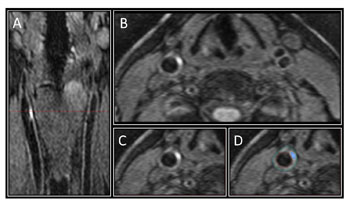3D MRI of the Carotid Arteries Could Indicate Early Signs of Stroke Risk in Diabetic Patients
By MedImaging International staff writers
Posted on 07 Dec 2015
The results of a new study indicate that 3D MRI exams of the carotid arteries in diabetic patients can show evidence of Intra-Plaque Hemorrhage (IPH).Posted on 07 Dec 2015
The researchers used 3D Magnetic Resonance Imaging (MRI) to study 159 asymptomatic type 2 diabetic patients, 37 of which had IPH in one or both carotid arteries, and five had IPH in both. IPH is an indicator of advanced atherosclerotic disease. The 3-D MRI exam showed that IPH was associated with an increased wall volume of the carotid artery, and was found in the absence of carotid artery stenosis.

Image: (A) The 3-D MRI Intra-Plaque Hemorrhage (IPH) sequence acquired in the coronal plane; (B) the reformatted axial plane; (C) the section of the right carotid artery; (D) contours drawn for the outer wall, and lumen, and the IPH area shaded blue (Photo courtesy of RSNA).
The average age of the patients, who were recruited from a dietary trial between 2010 and 2013, was 63 years. The study is being presented at the annual meeting of the Radiological Society of North America (RSNA 2015). The findings suggest that 3D MRI of arteries could help determine stroke risk for patients with diabetes. These patients may already have advanced vascular disease that was undiagnosed.
Study author Tishan Maraj, MBBS, imaging analyst, Sunnybrook Research Institute (Toronto, Canada), said, "A recent analysis of multiple studies has shown that people with carotid artery narrowing and IPH have a five- to six-times higher risk of stroke in the near future compared to people without. It was surprising that so many diabetic patients had this feature. We already knew that people with diabetes face three to five times the risk of stroke, so perhaps IPH is an early indicator of stroke risk that should be followed up. The advantage of 3D MRI is you can image the entire carotid artery and pinpoint the area of interest over a shorter period of time compared with multiple 2D sequences. Even though you can't treat IPH, you can monitor patients a lot more closely.
Related Links:
Sunnybrook Research Institute














